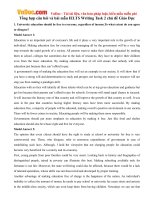Bài mẫu IELTS Bar Graph - 2
Bạn đang xem bản rút gọn của tài liệu. Xem và tải ngay bản đầy đủ của tài liệu tại đây (186.24 KB, 5 trang )
VnDoc - Tải tài liệu, văn bản pháp luật, biểu mẫu miễn phí
Bài mẫu IELTS Bar Graph - 2
The diagram below shows the average hours of unpaid work per week done by people in different
categories. (Unpaid work refers to such activities as childcare in the home, housework and gardening.)
Describe the information presented below, comparing results for men and women in the categories
shown. Suggest reasons for what you see.
You should write at least 150 words.
Model Answer 1:
The graph shows data between married men and women of the number of hours spent per week on
unpaid work. At first glance at the chart, it is noticeable that from all the three categories (without
children, with 1-2 children and with 3 or more children), married women spend more hours involved in
unpaid work such as housework, gardening and childcare than expected from men.
Married women with children spend more time than without children as the chart shows while having
more than three children have invested around 60 hours of unpaid work. This is probably due to the extra
load of housework and childcare that is evidently needed to run such a big family.
VnDoc - Tải tài liệu, văn bản pháp luật, biểu mẫu miễn phí
Furthermore, though there are visible variations of the number of hours of unpaid work carried out by
married women, there is no significant variation among all three categories for married men in terms of
work hours that is not paid (30 or fewer hours). In fact, it is observed that married men with three or
more children spent slightly less number of unpaid work hours. This might be due to the high
requirement of commitment needed for a paid job to meet financial requirements for a big family.
In conclusion, married women with three or more children spent the highest number of hours, yet
married women from all categories spent a dramatically higher number of hours for unpaid work than
married men.
[Written by - Menu Anju ]
Tips for answering this Academic IELTS writing task 1:
1. Look at the question carefully. It asks you to compare the result shown for men and women. So you
should not only mention the figures given in the graph. Rather you should use comparisons. An example
of comparison is: "The number of unpaid working hours increases for women with the increase of their
children's number but that does not affect the total unpaid works done by the men."
2. The question also asks you to suggest reasons for what you see. So you would require giving reasons
possibly why the women work more unpaid works that men do and why their working hours in unpaid
works increases with the number of total children.
3. There is an interesting fact in the result of the bar graph i.e. men with more than 3 children work even
less for the unpaid jobs. Mention this interesting fact in your writing.
4. Since no past year or month is mentioned in this bar graph, your answer should be in present tense.
Example: Women spend more time on such unpaid household works than men do.
Summary of the bar graph:
This graph shows the total hour of unpaid jobs like child rearing, household works, cooking, cleaning,
gardening etc done by male and female per week. The result of this graph is not related to the paid job of
men of women. The result suggests that females spend more time on such jobs than men do. Again,
female with more children works more hours than other females. Interestingly the numbers of hours men
work in such unpaid works remain almost same regardless of their children number.
Model Answer 2:
The given column graph elucidates the unpaid work done by both married men and women having
different numbers of children. A cursory glance is adequate to mention that most women, with or
without children, have to do the unpaid household works more than men and more children means
more work for women.
As is seen in the given illustration, married females who do not have any child do around 30 hours of
unpaid work weekly, while, male from the same category do only 18 hours of such work. Whilst, men
who have one or two children spend an equal amount of time for household works as do the males
without children, this is in contrast nearly fifty hours for women. In the case of women, who nurture
VnDoc - Tải tài liệu, văn bản pháp luật, biểu mẫu miễn phí
more than three offspring, spend the highest hours on unpaid works -58 hours per week. Men on the
other hand, surprisingly do fewer household works with the increase of their child number.
[Word count = 152, Written by - Arora]
Sample Answer 3:
The given column graph shows information on the amount of unpaid works done by men and women of
different categories.
As is presented in the illustration, married women who don't have children do the unpaid-works
(gardening, child care and household works) 30 hours per week whereas married men do the similar
unpaid jobs for about 18 hours per week. Women, who have one or two children do such work for 50
hours/week but the men from the same category do only 17hours (approximately) each week. The
women who have more than 3 kids seem to work the highest amount of unpaid works per week and that
is nearly 60 hours. Surprisingly male from the same category work even less; amounting only 16 hours
(approximately) of unpaid works.
In summary, women do the most of the unpaid jobs compared to men and with the increased number of
children this workload for women increases. This is possibly because more men than women get busy at
paid job and women stay home more than men do. As a consequence, women have to do more unpaid
jobs like childcare, gardening, cooking and household tasks than men.
(Approximately 191 words)
( This model answer can be followed as an example of a very good answer. However, please note that
this is just one example out of many possible approaches.)
Sample Answer 4:
The given line graph compares the hours of non-paid jobs done by male and female with different
numbers of children in an average week. As is observed from the graphs, women worked significantly
more hours than men for the household works like child caring, gardening etc. Also, the number of
hourly works done as unpaid works got higher with the increase of child number.
As is presented in the line graph, married women work around 30 hours per week for household unpaid
works while the men from same category work for only 18 hours. The works done by females with 1-2
children per week is more than 50 hours and with 3 plus children the work done by females is 60 hours.
Interestingly, the volume of unpaid jobs done by males does not change with the number of kids they
have except for the men with more than three kids who works even less unpaid household works.
In conclusion, we can say that the volume of unpaid works like household works and child caring
increases for women with the increase of their children's number but for men, this remain the same. And
female works significantly more hours for that type of household works than the men do.
(Approximately 208 words)
VnDoc - Tải tài liệu, văn bản pháp luật, biểu mẫu miễn phí
Sample Answer 5:
The given bar graph depicts the average hours of unpaid work done in a week by different categorised
people such as married women and men without children, with 1-2 children and with more than 3
children. The first point to note is that men do almost an equal number of hours of work in all three
categories.
Men occupied with unpaid works around 18 hours per week in the given groups. On the other hand,
women of the given two categories were engaged with 3 fold hours of men’s unpaid work. That is, 50
and 55 hours per week by married women with 1-2 children and with more than 3 children respectively.
Interestingly, married women without children have done almost half of it that is 30 hours per week.
To sum up, it is clear from the graph that married women were doing more hours of unpaid work
compared to married men irrespective of their number of children.
(Approximately 208 words | Written by - Jayesh Joseph)
Model Answer 6:
The given diagram presents information on average weekly unpaid working hours of married men and
women according to their family members’ number (without children, 1-2 children, with 3 children). It
is clear that women spend more time doing the unpaid works than men do. The unpaid works mainly
involve household and child upbringing works like housework, taking care of children, and gardening.
As is illustrated in the diagram, more the number of children the more unpaid working hours could be
observed in the case of women and the reverse scenario is true for unpaid working hours of men.
Women without children work about 30 hours of unpaid works per week while it is about 17 hours for
men without children. The unpaid working hours increases significantly when a married woman has
children. For 1-2 children this working hour stands at over 50 hours per week and for 3+ children it
reaches to about 60 hours. Interestingly, the weekly unpaid working hours for married men decrease
very slightly with the increase of children in the family. While a man works for about 17 hours of unpaid
tasks weekly if has no child this working hour decreases to nearly 16 when he has children.
This is a possibility because women most of the time stay at home and do more household and
child-rearing tasks than men do. Men, on the other hand, works outside and do less household related
tasks. Again married women with children need to work more on such tasks than married women
without children.
[Written by – Israa]
Model Answer 7:
The given graph compares the average time spend on unpaid works per week by married men and
married women having a different number of children. This nonpaid works mostly involve activities and
tasks like cooking, cleaning, taking care of children, housework, and gardening.
VnDoc - Tải tài liệu, văn bản pháp luật, biểu mẫu miễn phí
Now turning back to the details, women without children spend 30 hours per week on unpaid activities,
while men, from this category, do around 18 hours unpaid tasks in seven days. It is noticeable that with
the increasing number of children the unpaid working hours for women increase significantly while it
remains almost the same for men. This difference between the duration of nonpaid household works
done by men and women largely rises with the number of offsprings. Women do about 52 and 58 hours
of unpaid activities respectively per week, while, men do fewer hours, approximately 18 and 16 hours a
week.
In conclusion, it is clear that women dedicate far time on unpaid work than men. In addition, the higher
the number of offsprings, bigger the amount of work for women. However, it does not influence the
average hours of men. In fact, it drops a little, as the number of children increases.
[Written by – Bianca]









